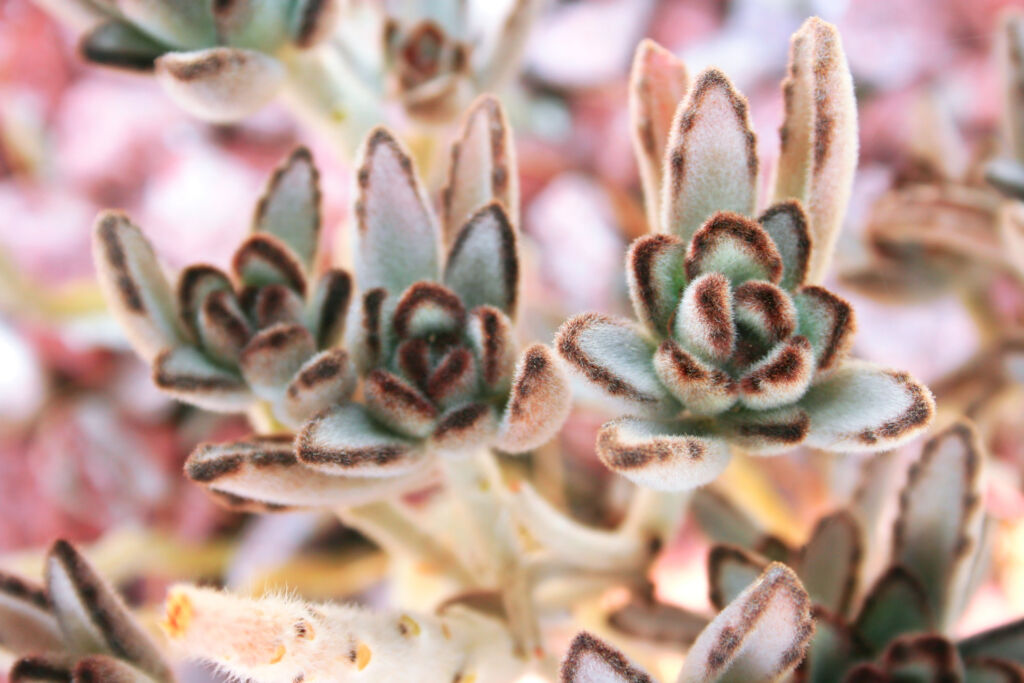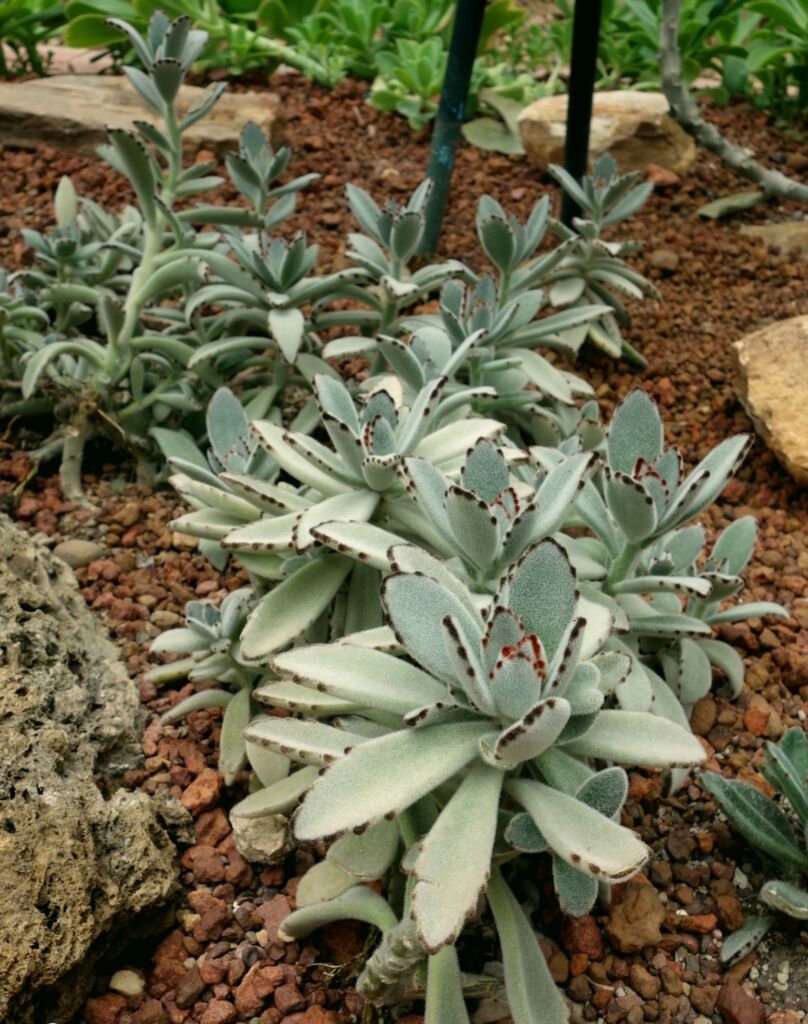HousePlantJoy is supported by our audience. When you purchase through one of our links, we may earn a small affiliate commission. As an Amazon Associate I earn from qualifying purchases. Your cost is not affected.
==================
Learn how to grow and care for these cute, low-maintenance, velvety leaves panda plants.
The indoor panda plants are hardy succulents and make an exciting addition to your houseplants indoors. They are among the children’s favorite houseplants, so growing a panda plant is an excellent specimen to locate in your child’s room as a piece of décor. These houseplants are relatively easy succulents to care for and maintain.
Panda Plant Care
The panda plant is native to Madagascar and features unique, velvety leaves that resemble cat ears. The thick leaves of these succulents have excellent water retention, which means they don’t need much watering. Once it matures, the houseplant can grow up to 1.5 feet with a thick stem, producing branches with several groups of leaves.
| Panda Plant Overview | ||
| Scientific/ Botanical Name | Kalanchoe Tomentosa | |
| Common Names | Panda plant, Pussy ears | |
| Origin | Madagascar | |
| Sunlight | Full to partial shade | |
| Watering | Typical water requirements for a succulent | |
| Height | Can grow up to 24” (61 cm) | |
| Width | Up to 24.” | |
| Zone | 9a (20F) | |
| Hardiness | Not cold hardy | |
| Propagation | By leaves | |
| Pet friendliness | Toxic to cats and dogs | |
| Dormancy | Summer dormant | |
The furry leaves that we have mentioned above are primarily oval-shaped, with a few growing randomly in whatever shape they want. A healthy panda plant’s leaves are grayish green with brown spotted tips. While the houseplant looks adorable, it is a hardy succulent and toxic for dogs and cats. So, it is highly recommended to keep the panda plant safe from your pets. Keep on reading the post to learn more about the panda plant.
Different Varieties of Panda Plant (Kalanchoe Tomentosa)
A few popular varieties of panda plants include:
· Chocolate Soldier (Kalanchoe Tomentosa)
One of the most common varieties of panda plants is the “Chocolate Soldier” houseplant. The classic panda plant variety produces relatively narrow, pale-colored leaves with brown leaf edges. Depending on where you want to plant the succulent and how much light it gets daily, the coloring of the leaf and the paleness of the leaves can be different.
· Nigra (Kalanchoe Tomentosa)
Nigra is another popular panda plant variety that you can grow indoors. One of the most significant differences that make these panda plants unique is their incredibly brown leaf edges that appear almost black. The border colors of Nigra houseplants can either have dots or run in continuous lines along the leaf edges.
· Rubra (Kalanchoe Tomentosa)
It is one of the most delightful varieties of panda plants. These succulents strike felt-like leaves with a reddish hue, pronouncing particularly along the leaf edges. Additionally, the houseplant as a whole also features a stunning golden-red shimmer.
Is Panda Plant Toxic?
Apart from their furry leaves and cute look, almost all panda plants are toxic to pets and other wildlife. If consumed by your pets in larger quantities, there would be symptoms like diarrhea, lethargy, and vomiting.
Panda Plant Care
Also, remember that all parts of panda plants are toxic because they comprise bufadienolides cardiac glycosides, which can cause troubles like severe weakness, irregular heartbeats, abnormal heart rhythm, etc.
In addition, once the plant gets stuck in your pet’s mouth, it could release insoluble calcium oxalate crystals, contributing to oral irritation in your pets. In such a scenario, ensure to attend and treat immediately.
Essential Tips to Keep Your Panda Plant Thriving
Panda Plant Care
Panda plants are often considered indoor succulents but can also be grown outdoors. In order to keep your panda plant healthy and thriving, they love to flirt with full. However, they can do well in medium sunlight as well. Just be sure to provide your plant with at least six hours of daily daylight.
· Watering Needs
Since the panda plant is one of the easiest succulents to grow and care for, its watering needs are pretty straightforward. This houseplant is especially a good option for people who often forget to water their plants or are running short of time. Panda plant leaves are thick and can store water for extensive periods, meaning the houseplant can survive with occasional watering.
Additionally, the ability to survive without frequent watering is another reason why panda plants are perfect for dry environments. Ideally, you will need to water your plants a couple of times a week, though these succulents can survive without water for a week or so.
However, it doesn’t mean that you should entirely neglect your panda plant and leave your plant without water for a month or so. Remember that while overwatering can essentially kill your plant, underwatering can severely affect its growth, causing the roots to dry out. In some instances, your plant may not survive as well.
Furthermore, ensure that you water it from the tip until the soil stops absorbing water. Alternatively, adding a small amount of water directly to the bottom of the pot is also possible. However, if that’s how you prefer the water, let the soil absorb as much water as possible and then remove the extra water.
In addition, try to keep the water away from the plant leaves because even the tiniest drop of water can encourage leaves to rot. In case you accidentally drop the water on the leaves, get a tissue and soak up the water immediately.
· Sunlight Requirements
As mentioned, panda plant succulents thrive in bright, direct sunlight. However, providing them with some partial shade once in a while is recommended. It will help your panda plant to keep the leaves protected from harsh sunlight.
Ideally, it would be best to place your plant along a sunny windowsill for a couple of hours, especially in the morning. During the afternoon, you can relocate it to any other spot where it can get partial shade. Additionally, if you are planning to grow your panda plants outdoors during the summer, do it gradually to prevent exposing your plants to sudden, direct sunlight.
Moreover, outdoor sunlight has a higher chance of scorching your succulent leaves, so this should be your top concern while relocating the plant outdoors. If you live in tropical conditions with plenty of sunlight, locating your plant in a shady area during the afternoon can help your plant keep thriving.
· Temperature Requirements
Like many other succulents, the panda plants also don’t have many requirements for temperature. Often, you will want to keep your plants in temperatures around 15 to 23 degrees to let them thrive. However, these houseplants can also thrive in slightly higher or lower temperatures.
Moreover, if you are planning to move your plants outdoors during colder temperatures, keep an eye and ensure to move them indoors the moment you notice the first few instances of frost. In failing to do so, your plant will be severely affected and may die.
Similarly, follow the same precautions when there’s excessive heat as it can also affect the growth of your plants, making their leaves scorch.
· Humidity
Panda plants love to thrive in climates with moderate humidity levels. This is especially true if you live in tropical climates with average humidity. People living in arid climates may need to water their plants more often than those living in tropical climates. Moreover, locating your plants in a place with proper ventilation is also essential for promoting healthy growth.
· Fertilizing Your Panda Plants
Panda plants are relatively fast growers. Although they have the characteristics of barren resistance, feeding your plants with occasional fertilization will encourage healthy growth. However, avoiding excessive fertilizer is essential to prevent any harm. Especially during the dormancy season, avoid feeding your plants with fertilizer.
Ideally, you would want to apply cacti or succulent-specific fertilizer during their growing season. Alternatively, you may also want to combine base fertilizer and base topdressing, liquid fertilizer and granular fertilizer, and organic and inorganic fertilizer.
· Pruning Your Plants
Once your panda plant establishes itself and reaches its average height, it generally produces many leaves and branches. The lower blade of these succulents is easy to age, turn yellow, or fall off. In such cases, it would be best to prune your houseplant to keep it thriving.
Moreover, if your plants have overgrown due to improper maintenance, you should consider pruning them to maintain their beauty. This will help your succulents to grow healthy and produce new branches. Additionally, regular pruning of your succulents is also beneficial, especially if you want to keep them short and retain dense foliage. In this regard, you can use special scissors and trim the stem to remove long leaves.
· Repotting Your Panda Plant
Panda plants should be repotted every two years or so because of two reasons. Firstly, the roots are expanding and growing out of the pot, indicating the houseplant is becoming root bound. Secondly, they need fresh soil and nutrients to keep thriving.
If you are planning to repot your panda plant, start the repotting process by sliding it out of its pot. Use your hands to break the packed dirt and root system gently. Next, try to remove as much dirt as possible from the roots and assess the root system. If you see any old, mushy, or molded roots, remove them.
Use a new pot that should be a few inches larger than your old pot. Additionally, it would be best to use a terracotta pot because they are great for absorbing excessive water to prevent root rot. However, if that’s not possible, use any pot that has enough drainage holes.
Since the panda plant is succulent, it prefers well-draining, dry soil. So, a premixed succulent or cacti-specific potting mix is excellent. Alternatively, you can also mix in the sand to improve drainage. Now, add a thin layer to your new panda plant pot, and then place your succulent, ensuring it sits at the same depth as it was in the older pot. Finally, fill the pot with soil, water thoroughly to expose air pockets, and let the water drain.
Panda Plant Pests and Diseases
Like many other succulents, your panda plant may also suffer from all the pests and diseases that bother other houseplants. It includes aphids, mealybugs, brown scales, root bugs, spider mites, etc. However, you can easily remove them using a cotton swab dipped in rubbing alcohol.
Panda Plant Care
In addition, the most common diseases that can affect your plant’s health include root rot, dry root, soft root, leaf spots, and powdery mildew. One of the effective ways to eliminate such issues is to inspect your succulents regularly, react quickly, and keep an eye on them afterward.
A few panda plant pests and diseases and their solution is given below:
· Mealy Bugs
If you notice a wooly white mass on your plant leaves tips, leaf axils, or cracks, it means your plant is under mealy bugs attack. Moreover, if you notice a loss of succulent vigor and discoloration, consider swabbing your plant with a 5% alcohol solution or insecticidal soap.
· Scale Insects
If you notice tiny, hard, brown moundlike insects on your plant stems or leaves, or if your plant is losing its vigor, it is affected by scale insects. In this case, insecticidal soap or alcohol solution can eliminate the risk of scale insects.
· Root Mealy Bugs
Wooly, whitish mass on your plant’s root, root collar, or inside the pot indicates the presence of mealy root bugs. In order to eliminate the risk, use tepid water or alcohol solution to clean the roots. Moreover, also ensure to prune aged, infected roots and relocate your plant to a new pot with well-drained soil.
· Spider Mites
Webbing or yellowish mottled spots on your plant leaves or at the growing tips means spider mites infect your plant. The best way to reduce the risk is to raise humidity and lower temperatures. Also, clean affected areas with insecticidal soap or a strong water spray.
· Root Rot
If your plant stops growing or if you notice yellow leaves and stems, it might be due to root rot. In this case, it is best to prune infected parts, repot your plant, and water less frequently.
· Dry Rot
If you notice small dark spots, slow growth, or if the body of your plant is turning pale and soft, it means your plant is suffering from dry rot. In order to prevent this, repot your plant using a fresh soil mix, water less frequently, and place your plant in a sunny spot.
· Powdery Mildew
If you see a downy, whitish substance on your panda plant leaves and stem, your plant suffers from powdery mildew. In order to prevent damage, make sure to place your plant in a place with increased air circulation and lower humidity levels. Additionally, use backing soda to treat affected parts.
Propagation of Panda Plant
· Propagation from Cutting
While growing a panda plant, excessive water and lack of light exposure can make your plant grow longer. That’s where you can carry out the process of propagation from cutting. During the process, you will need to cut a branch, put it in a well-ventilated, cool place, and wait for the wound to heal.
Then use wet sand that should be loose and breathable with good drainage. Once you place the cutting in the sand, keep it away from excessive sun exposure. It might take up to twenty days to establish roots and sprout.
However, avoid propagating your panda plant during the dormancy period (summer), which should be done during the growing season, spring and autumn.
· Propagation from Division
In addition to cutting, you can also propagate your succulent from division. Just like cutting, the ideal time for division is spring or autumn. If your houseplant has strong growth and dense pseudo corns, make sure to reserve at least five of them on each cluster after division.
Also, remember to keep the soil dry and reduce watering frequency before propagating from division. Additionally, placing a layer of broken tiles at the bottom of the pot and then laying a layer of coarse-grained stones to cover one-fifth of the pot is essential for the division method.
Once you are done with division propagation, pour some water carefully and then place the pot in a well-ventilated and cool place for at least 10-15 days. Furthermore, ensure to water frequently to keep the soil moist.
· Propagation from Seed
Panda plant propagation from seeds is one of the most complicated methods. Since the seeds are tiny, they have only one embryo that isn’t fully developed. It also means that propagation from seeds will slow the germination process. Additionally, the seed coating is very hard, making the water absorption hard. Therefore, supplying nutrients to your succulents through artificial culture can help them germinate faster. That’s why many gardeners prefer propagating panda plants from cutting or division. Still, if you are confident enough and want to propagate from seeds, choose a panda plant fruit that hasn’t cracked and take the seeds out.
Once you have the seeds, soak them in 10% sodium hypochlorite for ten minutes, take them out and wash them with water, and then put them in a bottle for cultivation. Also, ensure to keep the nutrient bottle in the dark culture room with a temperature of up to 25 degrees. Once you notice germination, move it to another place with adequate light.
Consider the Panda Plant for Your Next Addition
The Panda Plant offers so much to your home. Their ease of care, minimal maintenance, and furry leaves make these succulents a perfect houseplant for novice and experienced gardeners alike. However, since almost all these succulents species are toxic, ensure to keep your pets away from them.











